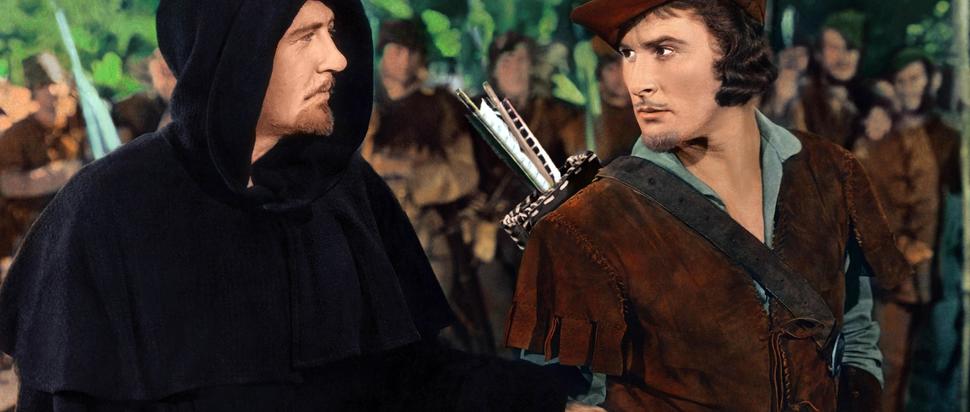Robin Hood and the Gender Canon
Ahead of the classic Errol Flynn swashbuckler The Adventures of Robin Hood screening at Cameo, one writer recalls how their obsession with the film helped shape their own ideas on gender
I was one of those children who could watch the same film every day for years on end – though I wasn't diagnosed with autism until I was an adult, go figure – and by the age of seven, I was already deep in the throes of a Robin Hood-themed mania that would continue throughout my life. I had already been dazzled by the swashbuckling woodland creatures of Disney's animated adaptation from 1973 and crawled my way through a supernaturally boring chapter book about the folk hero's exploits. When my mother came home from the library with a VHS copy of The Adventures of Robin Hood (1938), that was the end (of it living on the shelves of the library).
The Adventures of Robin Hood, starring Errol Flynn and Olivia de Havilland, was a technicolour extravaganza featuring a cast of thousands, Hays Code-compliant homoeroticism, and the exact right amount of horse stunts. This month, the film will show at the Cameo as part of a one-day Picturehouse event. I've never seen the film in a cinema, and its return has me thinking about what it has meant to me.
A few years ago, I was fortunate enough to speak to Xuanlin Tham about the genderqueer resonances I found in the film for their chapter in the Edinburgh International Film Festival essay collection From Troubled Dreams Under A Glare of Sky. Tham included my thoughts in a series of interviews on films that are gender-biographies for us. I've written about Robin Hood a few times in my adulthood, but this was the first time I put my queer feelings about the film into words. I recall focusing much of my obsession on the character of Will Scarlet, Robin Hood's musically-inclined bestie. "He doesn't carry weapons; he only has a lute," I said. "I saw that and was like, that's me. That is my gender. I am Lute Gender." (Will does actually carry a sword, but we only see him use it once.)
The character, particularly in his interactions with Robin Hood and the Merry Men, is queer in all the ways we're familiar with: he refuses to engage in Robin's staff measuring contests, choosing instead to make wry commentary; he's called things like "pretty fellow"; and, even when the men of Sherwood change into their forest-coloured costumes, he retains his red hat and collar. Because aesthetic is everything.
The film contains queer resonances that, above all, demonstrate to me that masculinity can (and must) look different from the idea of masculinity the state demands. I love it as much as anyone can love such an open piece of Eurocentric propaganda (an embarrassing amount). There is an ecstatic sense of possibility in the Merry Men's forest settlement, where oppressed people take up arms against an unjust regime. Robin's oath goes beyond stealing from the rich to give to the poor. He continues: "To shelter the old and the helpless, to protect all women, rich or poor, Norman or Saxon… and swear to fight to the death against our oppressors."
In The Adventures of Robin Hood, these colourful, affectionate and passionate scamps are the manliest of men. Their relationships with women and with each other are mediated by their commitment to their cause. Robin Hood was the springboard by which I came to understand queer expressions as expressions of revolt. Anxieties about the masculinity of the Merry Men are played out in later adaptations like Mel Brooks' Men in Tights (1993), in which the men perform a satirical musical number insisting that, despite the tights, they are still very manly. Errol Flynn and his crew make no such proclamation. They glitter, they flirt and they revel; their earnestness is part of their power. They are truly free.
Of course, Errol Flynn's Robin Hood also waxes poetic about the importance of fighting for a "free England", and instead of ignoring that, I think it's both possible and vital to hold that alongside the messages that still speak to me. It isn't that the story being about English people makes it morally wrong (I guess), but the linguistic framing around defending this specific image of England can be found in contemporary rhetoric that incites violence against migrants and asylum seekers. The story of Robin Hood in this adaptation leans on the age-old wish of the English to demarcate who is and isn't one of them – a process that we see deployed today to justify violence against marginalised people.
Thinking cynically, this film resonated with my child brain because it makes the messy, emotionally fraught act of rebellion unequivocally righteous under the world order. As a piece of my own personal gender canon, it's a queer superhero film; it's a fable about the power of community action. Over 20 years after I first saw it, The Adventures of Robin Hood remains at the heart of how I think about freedom.
The Adventures of Robin Hood screens at the Cameo, Edinburgh, 20 Aug, 5.30pm
